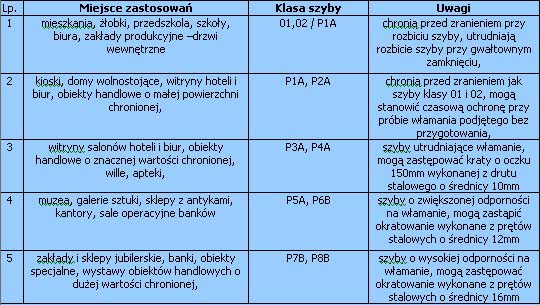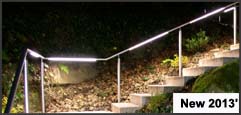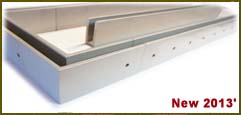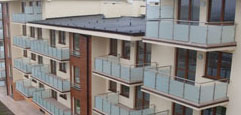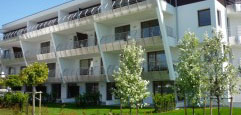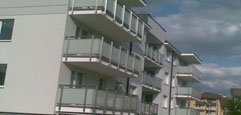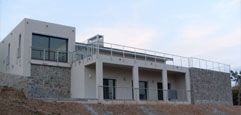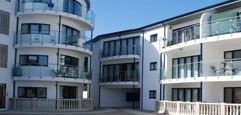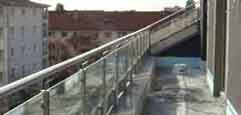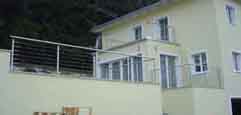The types of glass used for the railings, canopy, glass structures.
Safety
Types of glass:
Tempered glass
The process of tempering glass exerts an enormous influence on its mechanical strength: ie. Breakage, bending and thermal resistance, eg. Sudden cooling or heating of the glass. The strength of tempered glass is higher even 6 times of ordinary glass. Tempered glass is also known as safety glass, as in the case of breakage, shatters into hundreds of pieces of secure ultra-compact. In the process of quenching the glass is heated to a temperature of about 700 degrees Celsius, and then rapidly cooling it with compressed air. The advantage of this process is that it does not affect the appearance and only changing the internal structure of the material. There is a possibility of painting and firing of safety glass in the quenching process. Thermally toughened safety glass is widely used in construction, the furniture industry, automotive, railways, aviation, shipbuilding many other industries.Float glass
Float glass is a product of the base used in the production of tempered glass, laminated, satin, sanded, varnished, etc. Treated Fire has a perfectly smooth surface, devoid of optical distortion. Float glass which is transparent, has a greenish or blue-green hue, particularly noticeable at the edges of the glass. Light transmittance depends on the thickness of glass and depends on the content of iron oxides in the glass body.- Application:
- - glass walls, glass doors, sliding doors
- - walls, shower cabins
- - glass design elements
- - glass stairs, glass floors, railings
White glass
Such glass is virtually colorless and greenish coloration characteristic of ordinary float glass has been entirely eliminated. A characteristic feature of a glass of white high permeability light and excellent transmission of solar energy. It is used wherever its aesthetic and optical properties, especially translucency are particularly useful.- Application:
- - glass walls, sliding doors, shower cabins
- - glass in kitchen
- - glass design elements
- - glass wall
- - glass floor
Sandblasted glass
Sandblasted glass is subjected to a mechanical process that involves interaction of the surface of the glass stream of fine sand (corundum) coming out of the nozzle at high pressure. This causes the surface of the glass then becomes rough and non-transparent (as a result of tearing by sand microscopic glass particles). In the case of sealing the glass part of the protective foil prior to matting, you can grind only in exposed places. This way you can compose formulas to perform blasted subtitles etc.Satin glass (milk)
Satin glass has a durable, uniform, matt surface which does not lose its properties over time. The matt surface is easy to clean and does not cause problems in maintaining proper hygiene. Satin glass has a high light transmittance, for maximum illumination of the interior while maintaining privacy. Matt surface effect is obtained by tarnishing (using etching) one of the parties glass. Acid etched glass meets, among others, in terms of thermal and acoustic insulation.- Application:
- - swinging and sliding doors
- - railings
- - partition walls for balconies
- - stair treads, floor plates
- - shower enclosures and bath screens
Glass doors
Glass doors have enjoyed in recent years more and more popular. This is mainly due to the numerous aesthetic and hygienic, which is why designers are more and more often, particularly in public buildings, bring solutions in which one of the elements of fixed partitions are glass doors. They can stand alone or as a component of internal walls of glass (ie. partition) or external (eg. in the building storefront).
Behind the glass doors is given to those whose wings - with the exception of hardware, or other accessories, they are made entirely of glass panels (glass single - single or layered glued or with double glazing).
Construction material is glass. Glass doors may comprise frames (usually made of aluminum) or can be a door without frames in which the wings are hinged mounted directly on the wall, usually the glass, or they are hinged spindle, fixed to the floor and the ceiling (in particular doors to rooms in office buildings).
Regarding the regulations, at the moment there are no standards and normative documents of national as well as European standards relating directly to the inner glass door. Recently published standard (EN 14351-1 Windows and doors - Product standard, performance characteristics - Part 1: Windows and exterior doors without resistance to fire and / or smoke control) controls while the external glass doors.
This standard makes reference to the glass doors without frames, but in its content there is no distinction between a glass door from the traditional door where the glass acts only fill the wings rather than design. It should also be noted that compared to the traditional door glass in the door it is necessary to position much greater emphasis on issues of safe operation. This involves technical characteristics of glass such as transparency and fragility that can cause harm, eg. At the falling man at the door (due to their omission) or hitting a hard drive or enjoy a glass. Door in recent years more and more popular. This is mainly due to the numerous aesthetic and hygienic, which is why designers are more and more often, particularly in public buildings, bring solutions in which one of the elements of fixed partitions are glass doors. They can stand alone or as a component of internal walls of glass (ie. Partition) or external (eg. in the building storefront).
Recommended use of safety glass and glass construction with increased resistance to break-in the table below:
